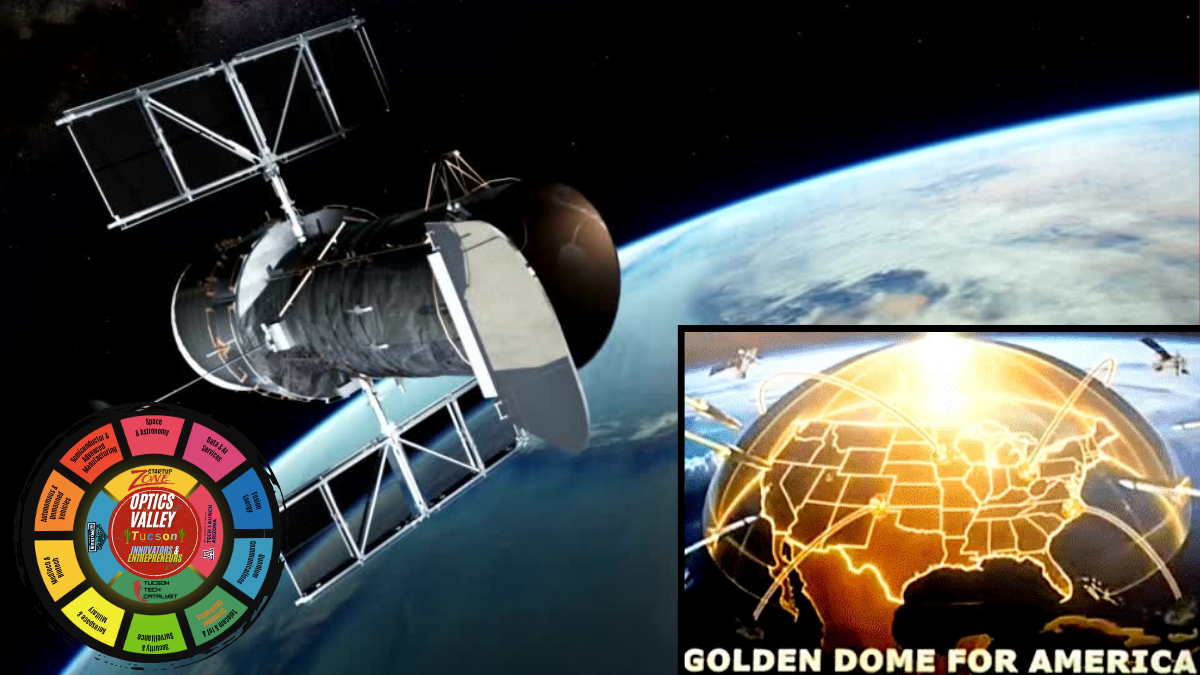Supercharging Space Exploration and Golden Dome with Optics Valley Tech
Light is at the center of almost everything humanity does to explore the universe and protect the planet. From telescopes that capture the birth of galaxies to defense systems that detect missile launches in seconds, the science of optics (how light behaves) and photonics (how we generate, guide, and detect light) is driving technological change faster than most people realize.
The same breakthroughs that let astronomers see farther into space also shape the systems that keep our country safe. Space exploration and defense are no longer independent worlds; they’re now connected by a shared goal: using light to sense, communicate, and act faster than ever.
The Power of Light
Optics and photonics make seeing and understanding what’s happening across vast distances possible. They allow satellites to detect heat signatures, lasers to send data across millions of miles, and telescopes to capture images of planets orbiting stars hundreds of light-years away.
In space exploration, they make communication faster and instruments more precise. In defense, they make detection and targeting systems more reliable. Together, these technologies form the foundation of what might someday become a real-life “Golden Dome,” a protective network of optical sensors and space-based systems that can see, react, and defend at the speed of light.
The Golden Dome missile defense vision represents the next frontier of optics and photonics in action. Powered by light, it combines space-based sensors, laser communications, and directed-energy systems to detect, track, and intercept threats at the speed of light.
The same technologies driving deep-space telescopes are redefining national defense from adaptive optics to integrated photonic chips. Precision, speed, and clarity are all powered by photons.
Optics and photonics aren’t just shaping how we explore the universe but how we protect it.
Space Exploration: Seeing Deeper into the Universe
One of the most striking uses of optics and photonics is in astronomical observation. Telescopes are the eyes of science, and today’s most advanced observatories use mirrors so precisely crafted that they can capture light from billions of years-old galaxies.
Researchers and students at the University of Arizona’s Wyant College of Optical Sciences are at the heart of this optical revolution. The college is world-renowned for training the engineers and scientists who design the instruments used in space exploration and defense systems. Working closely with the Richard F. Caris Mirror Lab beneath the stands of Arizona Stadium, the university has become a global leader in telescope optics.
Inside the Mirror Lab, enormous mirrors up to 8.4 meters across are spun and shaped using a unique process that melts glass in a rotating furnace. The result: lightweight, powerful, and perfectly curved mirrors. These mirrors are not ordinary pieces of glass; they’re feats of engineering that will form the core of some of the largest and most advanced telescopes ever built.
One of the lab’s crowning achievements is the Giant Magellan Telescope (GMT), now under construction in Chile’s Atacama Desert. When complete, it will have seven of these massive mirrors arranged to act as a single optical surface nearly 25 meters across. That’s about ten times more powerful than the Hubble Space Telescope.
The GMT will be able to study exoplanets orbiting other stars by directly imaging them and analyzing their atmospheres. It will peer into the formation of galaxies, study black holes, and help scientists understand dark matter and dark energy. The University of Arizona’s Optical Sciences team has been deeply involved in designing the adaptive optics systems that will correct for distortions caused by Earth’s atmosphere, allowing the telescope to achieve breathtaking clarity.
Adaptive Optics and Astrophotonics
Adaptive optics is one of the greatest success stories in modern photonics. Using mirrors that can change shape thousands of times per second, these systems cancel out the atmosphere’s blurring effects. What was once a fuzzy image becomes crystal clear.
The same adaptive optics used in astronomy has direct military applications. In defense, adaptive optics and fast beam steering stabilize laser beams, improve targeting precision, and maintain high-quality communication between satellites.
Another emerging field, astrophotonics, combines photonics with astronomical instrumentation. Integrated photonic chips can replace bulky telescope optics, making instruments smaller, lighter, and more stable. These same photonic circuits can be used in satellites, drones, and defense systems, where space and power are limited.
At the University of Arizona, scientists are using astrophotonics to build instruments that can split starlight into thousands of wavelengths and study the chemical fingerprints of distant worlds. In defense, similar photonic chips could enable hyperspectral imaging sensors capable of identifying materials, vehicles, or threats by their unique optical signatures.
Laser Communications: Light-Speed Data
Space exploration also depends on communication. Spacecraft have used radio waves for decades to send data back to Earth. However, radio has limited bandwidth, and antennas are large and heavy. Enter laser communications, which transmit data using light instead of radio.
NASA’s Deep Space Optical Communications (DSOC) system recently made history by successfully sending high-speed data from millions of miles away. Lasers allow data rates hundreds of times faster than traditional radio, using smaller antennas and less power.
In the future, missions to Mars or the outer planets will use optical links to stream 4K video, send scientific data faster, and even enable real-time telepresence, with astronauts communicating with Earth via high-definition light beams.
This same technology is being adapted for defense. Satellites in orbit can now share data through laser crosslinks, creating high-speed optical networks that are more secure and harder to jam than radio-based systems. These optical “backbones” could form the communication grid for advanced defense architectures like the Golden Dome, where rapid coordination and instantaneous data transfer are crucial.
The Golden Dome: Defense at the Speed of Light
The “Golden Dome” is more than just a concept; it’s a vision of how future defense systems might work. Imagine a global network of satellites equipped with optical sensors, infrared cameras, and high-energy lasers, all linked through optical communication channels.
When a missile is launched, its infrared signature would be detected instantly by space-based optical sensors. That information would be sent at light speed to other satellites and ground stations, which could respond in seconds.
Next-generation defense systems are exploring using directed-energy lasers to intercept or disable threats in their early stages of flight. These high-power lasers rely on precise optics and photonics for focusing, beam control, and adaptive correction. The challenges are huge: generating enough power in space, keeping the laser cool, and maintaining beam stability over long distances, but the progress is real.
Optical technology enables better detection and tracking of smaller, faster objects like hypersonic missiles or space debris. Hyperspectral imaging, lidar, and adaptive optics systems can spot and classify these targets faster than traditional radar systems.
Challenges and Opportunities
These advances don’t come easy. Space is a brutal environment filled with radiation, extreme temperatures, and micrometeorites. Optical systems must remain perfectly aligned for years despite constant thermal expansion and vibration.
High-power lasers in space also face heat management issues, since there’s no air to carry heat away. Engineers are exploring new radiation-hardened materials, optical coatings, and thermal control systems to stabilize optics.
There’s also the challenge of scaling. Building and launching one telescope or satellite is hard enough, but building hundreds or thousands of optical platforms for global defense requires mass production, modular design, and new manufacturing methods.
This is where the University of Arizona’s ecosystem shines. The combination of the Mirror Lab, the Wyant College of Optical Sciences, and local industry partners in Optics Valley makes Southern Arizona one of the world’s leading centers for optical and photonic innovation. Today’s identical talent building space telescopes could be developing tomorrow’s optical defense systems.
A Future Built on Light
From the Giant Magellan Telescope to the Golden Dome, optics and photonics redefine humanity’s ability to explore and protect. They help us see galaxies being born, study the atmospheres of distant planets, and guard against threats closer to home.
As the line between space exploration and defense continues to blur, one truth remains clear: light is our most powerful tool. It carries our data, our discoveries, and our defenses. It is the bridge between science and security.
The future isn’t built from metal alone in a world that depends on clarity, speed, and connection.
It’s built from light crafted in mirror labs, shaped by photonics, and guided by the minds who see beyond the visible.








